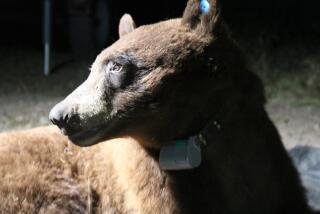Killer Bees Identified in Colony Seen in Calabasas
CALABASAS — A colony of killer bees has been found in Calabasas, meaning the aggressive insects probably have spread throughout the San Fernando Valley, county officials said Monday.
The March 5 discovery of a hive of Africanized honey bees in an oak tree in Calabasas marks the farthest north the bees have been reported in Los Angeles County since first being sighted in Lawndale last fall.
As a result, county agricultural officials believe the bees now have colonized 40% of the county, and will probably complete their march north by the end of the year.
“They’re moving quite, quite rapidly into new areas,” said Robert Donley, deputy director of the county agriculture department. “Residents should be careful about being around colonies or even a swarm of bees.”
There have been no reported attacks in Los Angeles County by the bees, which are much more aggressive than their European counterparts. However, a gardener was stung more than 90 times in San Bernardino last year after startling a hive with a weed cutter. At least five people in the southern United States have been killed by the bees, which can attack in a swarming mass.
In the latest sighting, a gardener working near the intersection of Park Ora and Park Helena in Calabasas discovered the bees flying in and out of an oak tree on the grounds of a private residence, according to county agriculture officials.
The bees were killed on-site as a precaution, but state officials didn’t confirm that the insects were Africanized honey bees until completing a DNA test last week.
Since the bees were found so far north from previous sightings in the southern part of the county, the DNA testing was done to confirm identification, officials said. Colonies or swarms of bees have been found in Commerce, Lynwood, Santa Fe Springs, El Segundo and Rancho Palos Verdes, as well as the communities of Del Aire and Lennox Park.
“What this tells us is that we probably have a number of other hives and swarms out there,” said Robert Saviskas, executive director of the Los Angeles County West Vector Control District.
The bees have also been found in Riverside County, though they have not yet been reported in Orange County.
County officials urged residents to call county bee specialists to report suspected hives or swarms of bees.
Residents seeking more information on the bees can call the agriculture department’s county hotline: (800) BEE WARY. Those seeking to have the bees removed may also call the vector control district’s hotline: (800) 925-3800.
(BEGIN TEXT OF INFOBOX / INFOGRAPHIC)
The danger:
The bees are no more harmful individually than the common honeybee, but their aggressiveness is legend-ary. Easily infuriated, they will swarm against a perceived danger, delivering hundreds of stings.
* How far bees will chase:
European bee:
Defends up to
450 yards
Africanized bee:
Defends up to
half a mile
* Time bees take to anger:
European bee: 19 seconds
Africanized bee:
3 seconds
More to Read
Sign up for Essential California
The most important California stories and recommendations in your inbox every morning.
You may occasionally receive promotional content from the Los Angeles Times.










